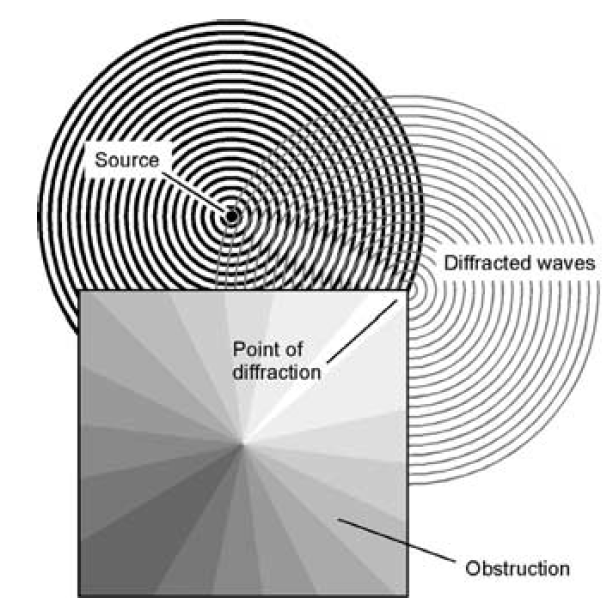
DIFFRACTION
 المؤلف:
S. Gibilisco
المؤلف:
S. Gibilisco
 المصدر:
Physics Demystified
المصدر:
Physics Demystified
 الجزء والصفحة:
452
الجزء والصفحة:
452
 26-10-2020
26-10-2020
 2224
2224
DIFFRACTION
Waves can gang up, fight each other, and travel in illogical directions at unreasonable speeds. They also can turn corners. Do you remember playing in the side yard when you were a child, hoping that you would not hear your mother call you from the front door? When the time came, the voice reached your ears anyway. How could sound find its way around the house? Your mother was out of your sight, and you were out of hers. Why should sound go places visible light could not? Doesn’t sound travel in straight lines, like light? Was your mother’s voice reflecting from other houses in the neighborhood? To find out, you conducted an experiment with a friend near an old, abandoned barn in the middle of nowhere, and her voice found its way around the structure even though there was nothing nearby from which the sound could reflect.
Sound turns corners, especially sharp corners, because of waves’ ability to diffract. When a wave disturbance encounters a “sharp” obstruction, the obstruction behaves as a new source of energy at the same wavelength (Fig. 1). The phenomenon can occur repeatedly. Even if you hid in the garage, you could still hear that voice. In a side yard three houses down the street, you could hear it. You noticed that the sounds from musical instruments, car engines, lawn mowers, and all sorts of other noisemakers can diffract too. As anyone who lives in a city knows that no one can hide from noise. Diffraction is one of the reasons sound is so pervasive. Long waves diffract more readily than shorter waves. As an edge or corner becomes sharper relative to the wavelength of sound, diffraction occurs

Fig. 1. Diffraction makes it possible for waves to “go around corners.”
more efficiently. As the frequency decreases, the wavelength increases so that all edges and corners become, in effect, sharper. This effect is not unique to sound waves. It happens with water waves, as any surfer knows. It happens with radio waves; this is why you can hear the broadcast stations on your car radio, especially on the AM broadcast band, where the EM waves are hundreds of meters long, even when there are buildings or hills between you and the transmitter. It happens with visible light waves too, although the effect is more subtle and can be observed only under certain conditions. All waves diffract around sharp corners. One of the tests by which scientists ascertain the wave nature of a disturbance is to see whether or not the effect can be observed from around a corner.
When an obstruction is tiny in comparison with the wavelength of a disturbance, the waves diffract so well that they pass the object as if it’s not there. A flagpole has no effect on low-frequency sound waves. The pilings of a pier likewise are ignored by ocean surf.
 الاكثر قراءة في الفيزياء العامة
الاكثر قراءة في الفيزياء العامة
 اخر الاخبار
اخر الاخبار
اخبار العتبة العباسية المقدسة


